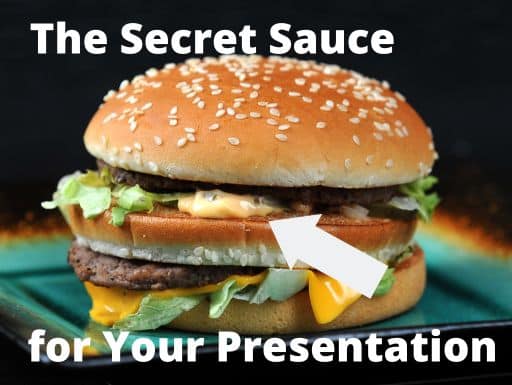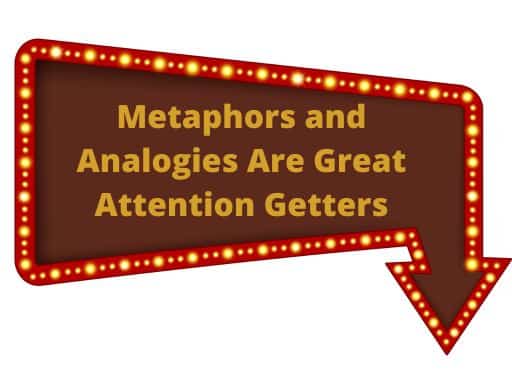
However, these often confused parts of speech are the special sauce to really great presentation burgers. If you use them just right, these items will be like adding the perfect piece of jewelry to a formal dress. They will take a speech that is already pretty good, and make it exceptional.
Metaphors, Similes, and Analogies… What the Heck is the Difference?
Simile: a figure of speech comparing two unlike things that use like or as to compare the two things. Here are a few examples.
- Her stare was as cold as ice.
- When he’s angry, he’s like an erupting volcano.
- That department is like a teenager doing chores.
Metaphor: a figure of speech in which a word or phrase literally denoting one kind of object or idea is used in place of another to suggest a likeness between them. Here are the same examples above as metaphors.
- Her icy stare said it all.
- His erupting anger is a little scary.
- The department’s teenager work ethic rarely accomplishes anything.
Analogy: a comparison of two otherwise unlike things based on resemblance of a particular aspect. With an analogy, one aspect of the two items are being compared, but there is often a logical inference that other aspects are also similar. Analogies tend to be more complicated than similes or metaphors. Here are examples of them.
- When I say something inappropriate, my wife is like a submarine. Her eyes shoot out a sonar-like signal, it bounces off my hard head, and later, I can expect an incoming torpedo.
- He’s kind of like a volcano. Most of the time, he’s calm and mild-mannered, but when he gets angry, he erupts.
- That department’s work ethic is like a teenager cleaning the garage — things get moved around a lot but nothing ever gets accomplished.
A good analogy often starts with a simple simile (or sometime metaphor). The fact that it does will often allow you to use a simile in a title or a bullet in your presentation, and then use humor to develop the analogy as content.
Five Ways to Use Similes, Metaphors, and Analogies to Add Flavor to Your Presentations.
- Attention Getting Titles (and Bullets).
- Add Humor to Dry Presentations.
- A Single Comparison Developed Throughout the Presentation.
- Use them with Other Evidence to Clarify Content.
- Make Technical Content More Easily Understood.
1) Attention Getting Titles and Bullet Points.

On a whim, I looked up the best-selling non-fiction books of the last few decades. Three of the top five used this technique. The #2 book is In Cold Blood by Truman Capote. Obviously, the criminal who the book is about has blood that is the same temperature as our blood, so the title is a metaphor. The title creates an emotion in the reader.
The #3 book is Maya Angelou’s autobiography called I Know Why the Caged Bird Sings. Angelou is creating an analogy between her tough childhood and a caged bird.
Finally, the #4 book is Fast Food Nation: The Dark Side of the All-American Meal by Eric Schlosser. The author of this book is using an alliteration from Star Wars as a metaphor for the way that we eat in the modern era.
The great thing about these titles is that they use very few words to create an emotional impact. In some cases, they also add a slight bit of humor. This leads us to another major benefit of similes, metaphors, and analogies…
2) A Good Analogy Can Add Humor to a Dry Presentation.

One of the young managers created a presentation about how two departments were working on the same project. However, neither of the departments was actually in charge of the project. They experienced a lot of misscommunication.
The departments communicated well within each of their groups. But neither communicated well with the other department. She said that it was like when she and her boyfriend decided to share a single bank account. He was keeping great track of his purchases. And she was also keeping great track of her purchases. However, no one was keeping track of BOTH purchases together. The audience laughed as they let the story unfold.
Interestingly, the more different the items that you are comparing, the more fun the comparison becomes. This story is funny because departments doing a project together is in no way like a boyfriend and girlfriend moving in together. (That and the story in and of itself was pretty funny.)
3) A Single Comparison Developed Throughout the Presentation Can Add Fun Throughout the Speech.

- Start with Training and Skill Development so You are More likely to Accomplish Your Goals.
- Create a Written Plan of Action.
- Look for Potential Obstacles that May Slow Your Progress.
- Set Milestones Along the Way.
- Take Corrective Action when Challenges Occur.
After I had the outline, I used the same airplane analogy all the way through the speech.
- Flight school and training.
- Create a flight plan.
- Check the weather map and make sure you have extra fuel.
- Flight following with towers along the route.
- Make course corrections.
So, as I delivered each bullet point and gave real-life examples of why each step was important, I also tied that step into the cross-country flight analogy. It was a fun way to tie my content into their theme. I worked beautifully.
4) Use Analogies and Metaphors with Other Evidence to Clarify Content.

Years ago, I heard a famous motivational speaker at a conference. One of the points he made was that the business world was constantly changing. To get ahead, you had to constantly change as well. To reinforce the point, he told a story about Albert Einstein.
A nervous teaching assistant approached Albert Einstein after the great physicist had mistakenly given the same final exam to two consecutive classes. “Dr. Einstein, it appears as though you gave this class the exact same questions on their final that you did last semester. Doesn’t that concern you?” Einstein thought for a second and then responded, “Yes, the questions are exactly the same. However, now, the answers are different.”
Of course, the speaker told the story very well, and the audience laughed. However, once the speaker finished the story, he moved on to another point. I remember thinking, “How in the world does physics test answers in 1950 changing have anything to do with technology changes in the business world now?”
The answer to that question is… well, nothing. All the speaker would have had to do was use an easy-to-find statistic or story about how fast the business world is changing today. For instance, according to Adobe, the iPhone has 5000 times the computing power of any super-computer from 1980.
So, keep in mind that analogies when used with solid proof or evidence work really, really well. When used by themselves, though, they will make your presentation kind of fluffy. It would be like feeding sugar-free Jello to a starving person. The person will devour the treat, but because the dessert didn’t give any real nutrition, it wouldn’t be much help.
5) Analogies Make Technical Presentation Content Easier to Understand.

You may need facts, figures, and statistics to teach your audience about a technical or complex topic. However, wordy explanations often confuse audiences. Good analogies can help!
For instance, people often come through our presentation classes to eliminate a symptom versus fixing the real problem. They think that they speak too fast. Or they want to avoid losing their train of thought. Others think that they say “uhhhm” too often. Each of those concepts is just a symptom of the bigger underlying problem, though. Treating the symptom doesn’t work unless you eliminate the root cause — the nervousness.
I took a presentation class in college. The graduate assistant who taught the class would critique us after each presentation. My first presentation was okay, but the teacher told me that I said, “Uhhhm seven times.” She asked me to work on that. However, the next time I spoke, I focused more on not saying “Uhhhm” and less on the actual presentation.
My grade actually went down. This time, I said “Uhhhm” 14 times. I got even worse on the third presentation. My focus was on treating the symptom versus fixing the problem.
A good analogy to describe this would be like when your “Check Engine” light comes on in your car. You can crawl under your dashboard and snip the electrical line that goes to that light. The light will go out. However, the engine problem will still be there. Eventually, that problem will get bigger and more expensive to correct. So if you just try to reduce the uhhhms or slow down when you speak, you are just making the light go off. You’re not fixing the engine problem.
Metaphors, Similes, and Analogies: The Special Sauce for Your Presentation Masterpiece
These simple figures of speech can easily add some flavor to your presentation masterpiece. Sprinkle in a few of these devices every now and then to spice up the bland speech. If you do, your audience will always want more from you.

